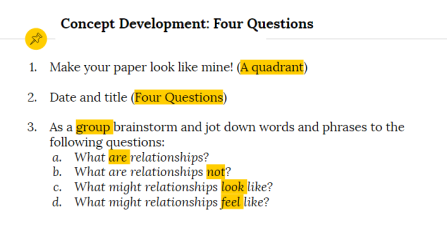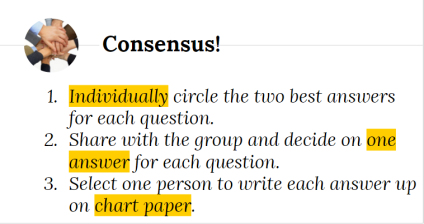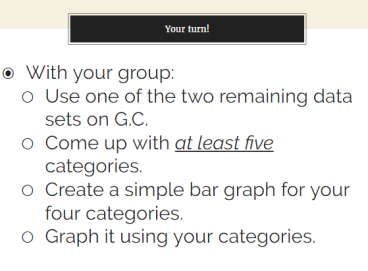Categorize, Graph, Infer: A Lesson in Concept Development
Concept development activities make me nervous.
I remember back to my student teaching. We were about to begin reading George Orwell’s fantastic book 1984. So, to get ourselves thinking about some of the themes relevant to the novel, I cooked up an activity about surveillance. I don’t remember the specifics of the activity, just that I hooked up a few classroom SMART boards to video cameras. I remember spending hours trying to create an environment that challenged the way students thought about surveillance and social control. After running the kids through some elaborate scenarios, I stood in front of the class ready to receive their accolades. A kid with a giant shock of auburn hair raised his hand.
“Wow, Mr. Anderson. That sure was a fun way to waste time! Is it time to start the real work now?”
Concept Development work doesn’t lend itself to the realm of the purely quantitative. For me, helping students break down and explore overarching concepts draws more from constructivism than positivism/empiricism. Constructivist theories of knowledge, at their core, situate the central components of learning within cognition and the faculties of the brain. Even though constructivism comes in many flavors (cognitive constructivism, social constructionism, and critical constructivism, for instance), each method emphasizes the active creation of the learning experience.
As most method courses will tell you, constructivist theories (and therefore concept development) draw heavily from work of Jean Piaget. According to Piaget, the process of learning is one of continuous adjustment. The brain is constantly struggling to maintain a sense of equilibrium. It does this by struggling to understand new concepts using what it already knows (assimilation) and changing what it already knows to incorporate what’s new and different (accommodation). Any educator practicing a form of constructivist pedagogy needs to help students build connections between new content and what a he or she already knows.
There’s no one constructivist pedagogy. That said, constructivist teachers typically seek to help students make and expand on conscious links between themselves and the content. So, while planning my upcoming unit on the concept of ‘relationships,’ I knew I wanted to start out by helping students work through the meaning of the concept. Additionally, a previous memory of being eyeball deep in a ‘belonging’ unit only to have a student say “I still don’t know what belonging means” had been haunting me. I wanted to do a better job.
Day 1
A quick search for ‘concept development map’ on Google yields a wealth of resources. I fished around online, dug through a few books, and wandered through the halls of my own memory before settling on four simple questions.

I wanted groups to tackle these questions because they’re actually quite complex. While students discussed and wrote down answers I circulated around the room, stopping a few times to wonder aloud whether relationships were always good or if it was possible to have a serious relationship with an inanimate object. I asked these questions to try and nudge each group beyond their established relationship schema that defined the concept as a dyadic bond between humans. My questions helped a few groups expand their answers to the four questions. The activity also let me get in a little ‘show, not tell’ practice. A relationship feels like comfort? Well, what’s comfort feel like? What about happiness? What might different forms of happiness look like? And so forth.

After brainstorming, I asked students to individually pick their ‘favorite’ answers to each of the four questions, share out, and then come to a consensus. One student from each group wrote each of the answers on pieces of chart paper hanging around the room. Next students did a quick gallery walk to check out everyone’s answers (which accrued mightily over the course of the day) and come up with their own definition for the word relationships. The final step was for each student share that definition with his or her group and then settle on one definition for the group.
Moving students in and out of group work is a definite hallmark of my teaching, for better or for worse. I try to strike a balance between difficult tasks best suited for a group (coming up with criteria, for instance) and individual assignments that allow for reflection and personal choice. The goal here is to foster an environment that honors introversion and extroversion in equal parts.
When each group settled on their definition, we threw them up on the board, debated them, and narrowed the options down to a single sentence. With Alfie Kohn’s adversarial majoritarianism in mind, I tried to create opportunities for students to push for consensus instead of merely asking them to vote. However, since I’m not that skilled at facilitating this sort of group discussion, the results weren’t stellar. Nor were they disastrous. At the end of the day I put the five definitions (one per period) on a Google Form for the students to vote on the next day. This might seem like a lot of work for a simple definition. I could have simply used a transmission approach and given it to them. But constructivism takes time. While we can’t obviously go this in-depth with everything, spending time creating a working definition of our overarching concept seemed worth it.
Day 2
After revealing the chosen definition, we went to work at bringing the concept a little closer to home. Earlier in the month I decided to split the unit into three sections; our study of relationships would cover objects (what objects do we cling to? what might that say about us?), places (what places do we hold dear? why are physical and online spaces so important?), and people (how do our relationships with people sustain us?).
We started out by examining the important P/P/O in the life of Cadence, the protagonist from our last read aloud, The Girl Who Was Supposed to Die. I had students begin with a fictional character because I wanted them to be strategic in their choices. In a well-written novel everything exists for a reason. Details typically serve larger goals of plot movement, character development, etc. Groups made lists of objects, people, and places and we discussed why each one was essential to the protagonist. I took the opportunity to throw in some more abstract questions. How would the plot have changed if Cadence gone to the police instead of ranger station? What effect did Michael Brenner’s cell phone have on the plot?
I then asked students to brainstorm the most important people, places, and objects in their lives. My hope was that they would choose their own answers with the same amount of care and deliberation as the novel’s. Next they picked the top answer for each category, wrote it on a sticky note, and posted it in a designated spot in the room. Here’s what the walls looked like about halfway through the day.
We took some time for a few off-the-cuff observations, but by the time the dust settled we barely had enough time to squeeze in our read aloud.
Day 3
The final day of concept development required students to analyze the data. In this case the data sets were the accumulated sticky notes for the three categories. Since drawing conclusions can be a fairly advanced skill, I spent a significant amount of time modelling the process. Before the day started I went through the objects category and took stock of every sticky note. I counted them (pretty easy considering 75% of students listed their phone) and then played around with putting them into different categories. The strategy of collecting information, categorizing, sub-categorizing, and etc. comes from Hilda Taba. I think it’s an incredibly powerful way to organize and draw conclusions about things. Once I had my categories straight I drew out a few crude bar graphs to make sure everything worked.
I walked through the process with students, relying on standard think-aloud protocols. I made sure to get student input on the final phases of my graph. Although I knew the ‘answers’ before hand, I wanted to make sure a few specific students were still with me and able to predict the next step (a severely truncated version of what’s commonly referred to as the gradual release model). After spending a fair amount of time on this I gave students their marching orders. Categorize, group, graph, and draw conclusions based on one of the two remaining data sets.

We spent the final minutes of class discussing everyone’s findings. Some of the questions turned out to be conversational goldmines (Why, for instance, did students mention ‘Mom’ five times as often as ‘Dad?’) while others were duds (Why didn’t any student list ‘school’ as his or her important place?).
Conclusions
The students appeared to enjoy the concept development activities and discussion. Although it certainly wasn’t perfect, nothing is and that’s not the goal. These three days, especially the graphing component, were the result of much hand-wringing and brainstorming. I’m lucky to have a great thought partner next door, Mr. Carter, my team’s math teacher. The time we spent spitballing ideas during our planning periods was enjoyable and useful.
Have any concept development activities that you love? Please share!



You always put so many details in your posts, Peter. Thank you for sharing!
LikeLiked by 1 person